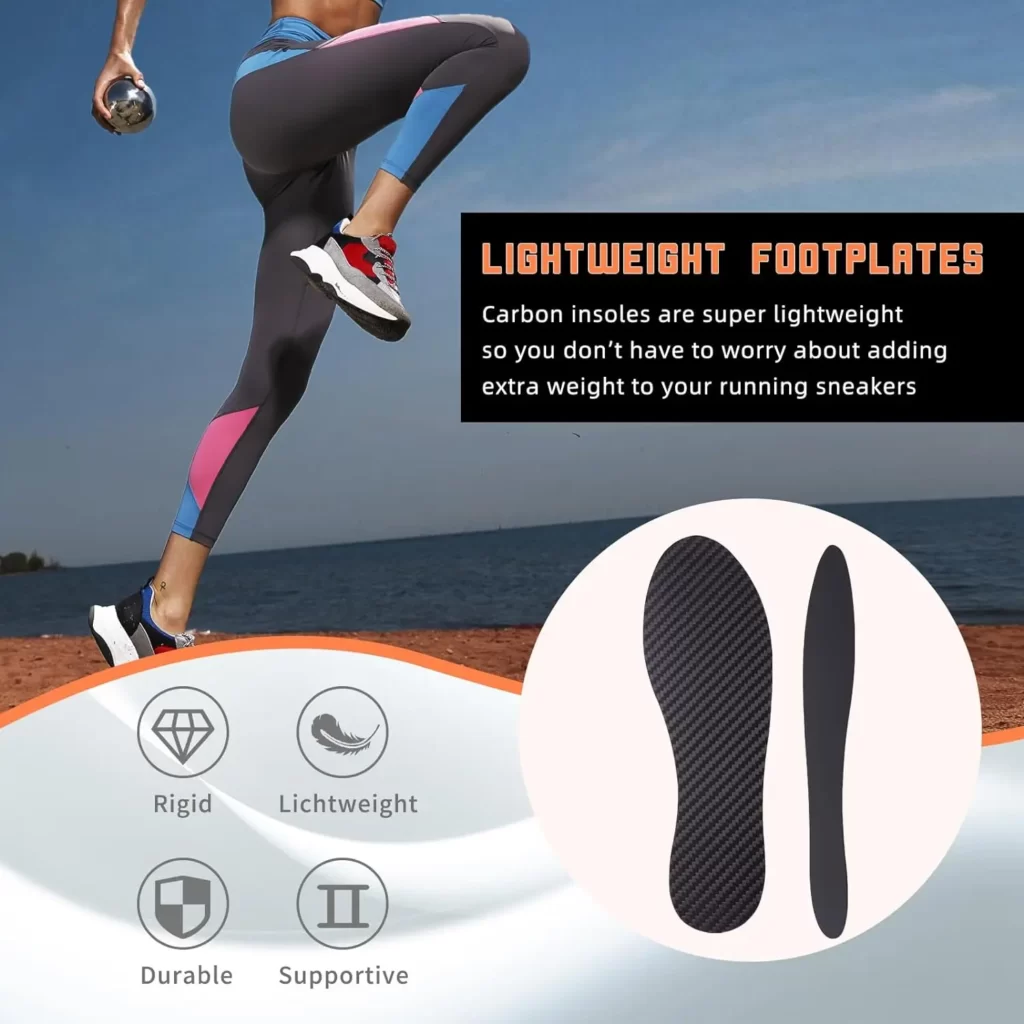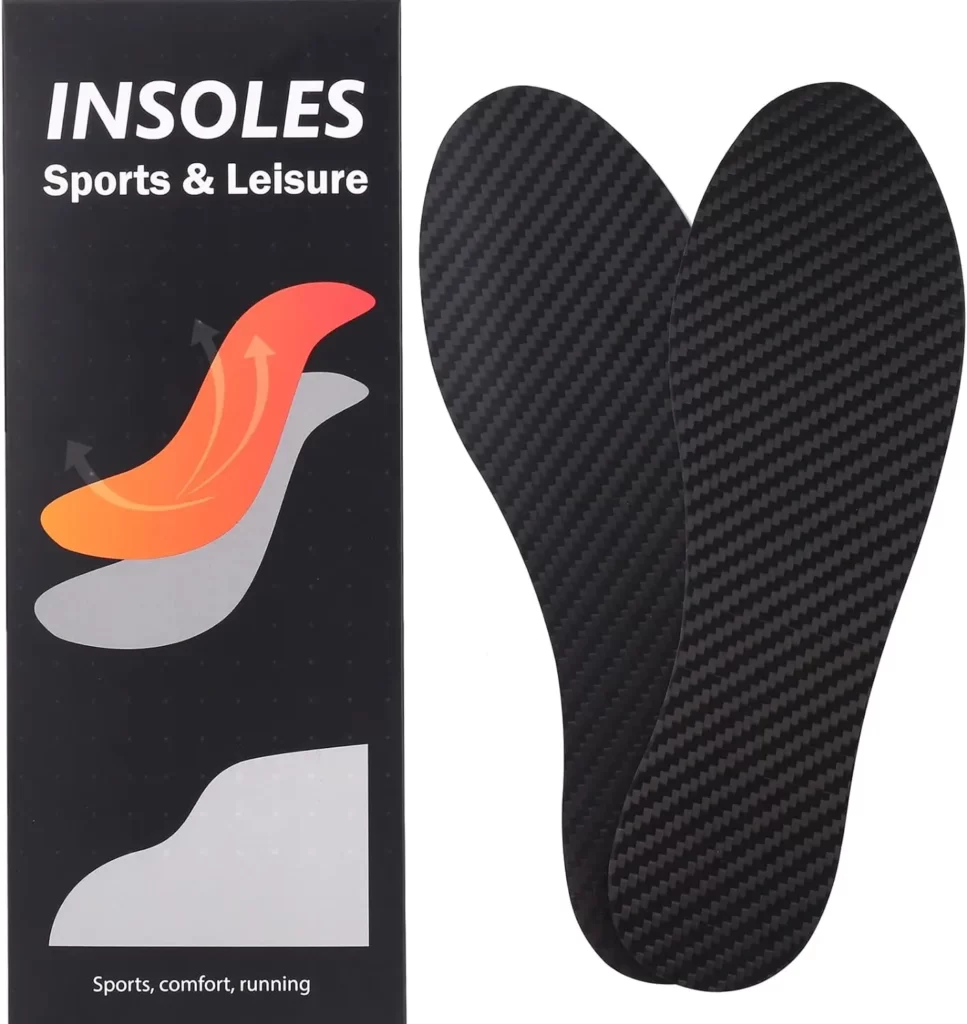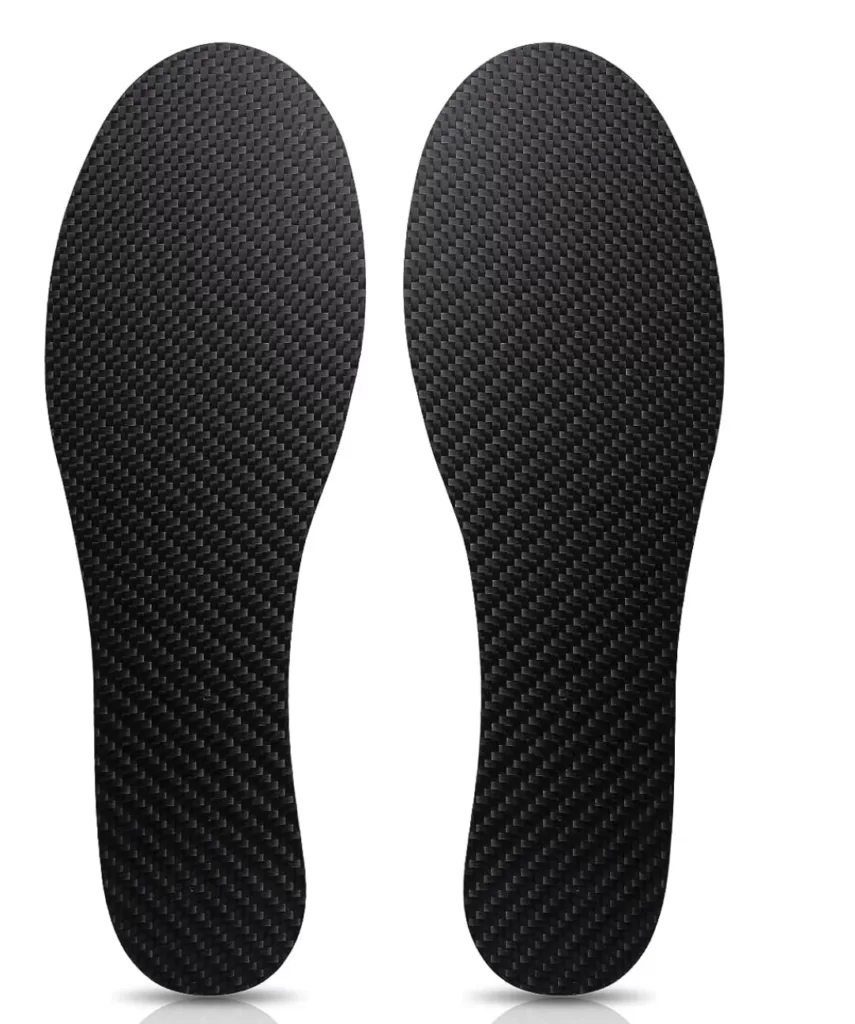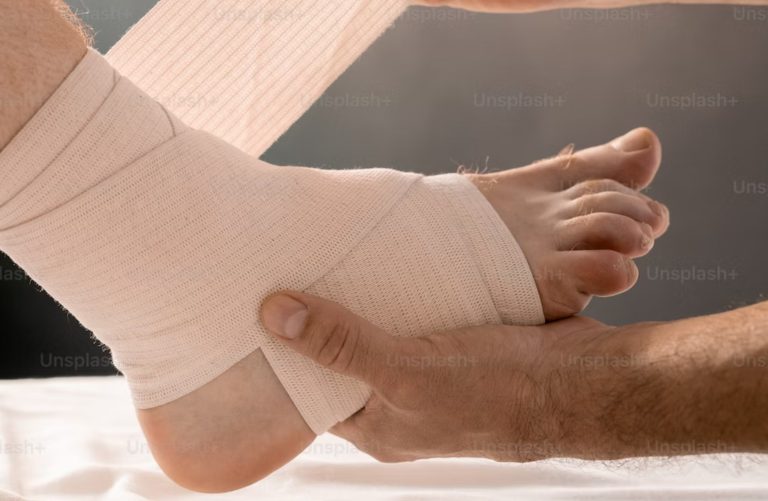Do Carbon Plate Insoles Really Give You a Spring in Your Step?
Introduction to Carbon Plate Insoles
Carbon plate insoles are a relatively new technology that has become popular among runners and athletes in recent years. As the name suggests, they contain a rigid plate made of carbon fiber that is inserted into the midsole of a shoe.
The carbon plate works by boosting energy return and propulsion. It also cuts lower leg fatigue and promotes a faster toe-off. This helps athletes run more efficiently by reducing wasted energy and enhancing speed.
Carbon plates first appeared in high-end running shoes around 2014-2015. Brands like Hoka One One and Salomon pioneered them in their racing shoes. Nike released the Vaporfly 4% in 2017. The shoes have carbon plates in them. They brought much attention to this tech in running.
Since then, the use of carbon plates has expanded. It’s gone beyond just running shoes. Now, they can be found in cheaper after-market insoles. Major brands offering carbon plate insoles include Roamingfeet, Propel, and FAKILO.
The key benefits these insoles aim to provide include:
– Increased energy return and efficiency
– Reduced leg muscle fatigue
– Faster turnover and toe-off
– Improved speed and momentum
– Enhanced stability and support

The insoles were originally designed for runners. But, now athletes in many sports that involve running and jumping use them. These sports include basketball, tennis, soccer, and CrossFit. They can provide a performance edge by enabling athletes to train and compete harder with less fatigue.
How Do Carbon Plate Insoles Work?
Carbon plate insoles work by providing increased energy return as your foot strikes the ground during activity. The carbon plate acts as a spring, absorbing impact and returning the energy back into your stride for a propulsive and efficient feel.
The plates are made from layers of ultra thin, light carbon fiber. This allows them to flex and store energy when you step. The carbon fibers are precisely shaped and oriented to maximize energy return in the right direction when compressed.

A foam or cushioned insole is soft. In contrast, the carbon plate is stiff. It resists compression to return energy, not absorb it. By improving energy return and reducing energy loss into the midsole cushioning, carbon plates make running and walking feel easier at the same speed.
The plate’s shape and stiffness can be tuned along the length of the foot to match the biomechanics of running or activity. Plates are often stiffest towards the front to return maximum energy into the toe-off, and more flexible at the heel for a smoother strike and transition through the foot roll.
When paired with a foam or rubber outsole, the carbon plate provides energy return for propulsion. It also provides shock absorption for comfort and protection. This optimized combination of performance technologies is what makes carbon plated shoes and insoles so effective for runners and athletes.
Benefits of Carbon Plate Insoles
Carbon plate insoles provide several key benefits for runners and athletes. The plates work by stiffening the shoe, allowing for an improved energy return. This leads to key advantages:

Increased energy return – The carbon plates act like springs, capturing energy when compressed and returning it with each step. This allows runners to use less energy per stride.
Improved running economy – With an enhanced energy return, runners can maintain pace using less effort and energy expenditure. The carbon plates make each stride more efficient.
Reduced fatigue – The energy recycling effect of the plates reduces the toll on the runner’s muscles during activity. By relying more on the carbon plates for propulsion, runners experience less fatigue during runs.
Injury prevention – The spring-like rebound of the carbon plates can reduce impact on joints and tissues. Runners are able to maintain form and performance for longer periods of time. Less fatigue and impact helps prevent overuse injuries.
The stiffness and recoil of carbon fiber plates make them an excellent addition to shoes and insoles for runners, walkers, hikers and other athletes. The energy return and cushioning support improved performance and comfort during activity.
Considerations When Using Carbon Plates
When deciding if carbon plate insoles are right for you, there are a few important considerations to keep in mind:
Proper fitting is crucial – Carbon plates are rigid and do not have much give or flexibility. It’s important that they fit your individual foot correctly, otherwise they may cause discomfort, pain, or injury. Most experts recommend visiting a specialty running shop and having your feet properly fitted by a knowledgeable employee who can assess your foot type, running style, and needs. Don’t rely on generic sizing charts. Take the time to find the proper size carbon plate that aligns with your arch and contours to your foot.
May feel rigid at first – Carbon fiber plates are hard and do not have the soft, cushiony feel of foam or gel insoles. The firmness allows them to propel the foot forward, but may feel quite rigid and unusual when you first use them. Allow yourself an adjustment period to get used to the sensation of the stiff plate underfoot. Start by wearing them for short periods, like on a test run, and gradually increase the duration. The rigid feeling should lessen over time as you acclimate.
Not suitable for all foot types – While carbon plates can benefit many runners and athletes, they are not ideal for every foot type. Those with extremely high or low arches, certain foot injuries, or sensitivities may not tolerate the inflexibility of carbon fiber. Do not force yourself to wear carbon plates if they cause pronounced discomfort or pain. Consult a podiatrist or sports medicine doctor if you have doubts about the suitability. They can examine your feet, running style, and medical history to advise if carbon plates are recommended for you.
Sports and Activities That Benefit from Carbon Plates
Carbon plate insoles can provide major benefits for certain sports and activities compared to regular shoe insoles. The carbon plate works by stiffening the midsole in order to provide a firm platform to push off from with each step. This can translate into more powerful strides, improved efficiency, and less fatigue.
Running
Runners stand to gain a lot from carbon plate insoles. The plates give a propulsive sensation with each foot strike, helping runners get more out of each stride. This can enable runners to maintain faster paces with less effort. Carbon plates are especially useful for long distance runners who need to conserve energy. Many record-breaking marathon times have involved carbon plated shoes.
Hiking
Much like with running, carbon plate insoles can make hiking less tiring. The stiff midsole allows hikers to stride more powerfully uphill and descend with better control. Hikers using carbon plate insoles may find they can cover more miles in a day with less fatigue. This can be advantageous for multi-day backpacking trips.
Tennis
The explosive start-stop motions in tennis can benefit from the snappy sensations of a carbon plate. Their stiffness provides stable footing for quick lateral movements and solid footing for forceful strokes. The plates help tennis players change directions sharply while maintaining balance. Increased energy return can also lend more speed to serves and groundstrokes.
Basketball
Basketball involves constant motion including pivots, cuts, jumps and sprints. A carbon plate insole creates a rigid lever that enables basketball players to push off forcefully when driving to the hoop or exploding upwards for a rebound. The plates also provide lateral stability for swift side-to-side shuffling on defense. Increased energy return from the carbon fibers can translate into extra lift on vertical leaps.
Cross-Training
Carbon plate insoles can help with cross-training. This type of training involves many different activities. Their performance benefits and versatility make them useful for many things. They work for everything from plyometrics to weight lifting. The plates are a solid, propulsive platform. They help cross-trainers get the most out of exercises. These exercises involve running, jumping, and agility work.
Carbon Plate Shoes vs. Insoles
For carbon plate technology, you have two options. You can get integrated carbon plate shoes or separate carbon plate insoles. The insoles can be put into any shoe. Each offers its own advantages:
Carbon plate shoes provide more structure and stability thanks to the plate being firmly embedded in the sole. The plate is designed specifically for that shoe model to deliver maximum energy return and efficiency. Carbon plate shoes are ideal for runners looking to improve speed and performance. Major brands like Nike and Adidas now offer carbon plate racing shoes.
Carbon plate insoles offer more flexibility and can be used across different shoes. The insoles can be swapped between various shoes you own for different activities. Being removable, carbon plate insoles allow you to customize the level of stiffness and responsiveness under your feet. They are great for casual runners who want to experiment with carbon plate technology without committing to new shoes.
Using both carbon plate shoes and insoles together can provide the ultimate benefits. The insoles add extra propulsion and bounce while the integrated plate in the shoes offer structure. This maximizes energy return for a super-charged running experience. Some ultra-marathoners use carbon plate insoles in their carbon shoes for maximum efficiency over long distances.
In summary, carbon plate shoes provide more stability and performance benefits. Carbon plate insoles offer more flexibility in different shoes. Using both together enhances overall energy return for avid runners.
Reviews of Top Carbon Plate Insole Brands
Carbon plate insoles are from leading brands like Roamingfeet, Spenco, and FAKILO Carbon. They provide the benefits of a rigid plate to improve energy return and impact absorption. Here’s an overview of some top carbon plate insole brands on the market:
Roamingfeet

Roamingfeet is one of the original carbon fiber insole brands. Their insoles feature a 100% carbon fiber plate that is ultra-thin and flexible yet highly rigid and responsive.
Pros:
– Very lightweight and minimalist
– Excellent energy return and shock absorption
– Antimicrobial and moisture wicking
– Works well for running and other high impact activities
Cons:
– Can feel too hard and uncomfortable for all-day use
– Expensive
Spenco
Spenco carbon insoles have a contoured carbon fiber plate. The plate is embedded in medical-grade cushioning.

Pros:
– Good arch support from contoured shape
– Cushioned for comfort
– Helps correct overpronation issues
Cons:
– Bulkier than other carbon plate insoles
– May wear out faster than 100% carbon options
FAKILO Carbon
FAKILO Carbon insoles feature a full-length carbon fiber plate, Addresses overpronation and uneven weight distribution, which can lead to discomfort and injuries.

Pros:
– Excellent stability and energy return
– Cushioned yet responsive
– Deep heel cup for support
Cons:
– Can be quite rigid at first until broken in
– Requires break-in period, may not be best for narrow feet.
Overall, Enertor is best for pure energy return for athletic activities, while Roamingfeet Spenco and FAKILO provide a more cushioned option better for all-day wear. Consider your needs and budget when choosing a carbon plate insole brand.
Cost Comparison of Carbon Plate Insoles
Carbon plate insoles come in a wide range of prices depending on the brand, materials used, and features included. Though more expensive than regular insoles, carbon plates deliver proven benefits for runners, athletes, and anyone who spends a lot of time on their feet. It’s important to consider your budget and needs when selecting a carbon plate insole.
The top carbon plate brands range in price from around $50 to over $200. Some of the major factors affecting price include:
– Materials Used: Higher end carbon plates use advanced materials like aerospace-grade carbon fiber, which costs more. Cheaper plates may use fiberglass. The plate’s thickness and rigidity also impact price.
– Brand Reputation: Well known brands like Enertor and SOLS command a premium compared to lesser known companies. You’re paying for the brand name and reputation.
– Overall Construction: More expensive insoles feature higher quality construction with precision engineering and durable materials built to last. Cheaper insoles may wear out faster.
– Made to Measure: Custom fitted carbon plates made to match your unique foot shape cost more than prefabricated, one-size options.
– Extra Features: Additional features like metatarsal support, anti-microbial coatings, or cushioning raise the price. Simple flat plates are cheaper.
Mid-range carbon plates from established brands like Roamingfeet and Spenco offer good value. They tend to balance quality and price. They provide proven benefits without breaking the bank. Consider how often you’ll use the insoles and your specific needs to find the best value carbon plate option for you.
Maintenance Tips for Carbon Plate Insoles
Taking care of your carbon plate insoles properly will help maximize their lifespan and performance. Here are some tips for maintaining carbon plate insoles:
Cleaning
– Remove insoles and wash gently by hand with mild soap and water after each use. This prevents buildup of bacteria that can lead to foot odor.
– Allow insoles to fully air dry before re-inserting into shoes. Don’t place them near direct heat to dry.
– Occasionally sanitize insoles by spraying lightly with a disinfectant spray and allow to fully dry. This kills germs and odors.
– Don’t put carbon plate insoles in the washing machine or dryer, as high heat can damage plates.
Storage
– Store carbon plate insoles in a cool, dry place out of direct sunlight when not in use.
– Keeping them in the original packaging or a sealed bag will prevent dust buildup.
– Don’t store anything heavy on top of insoles for long periods, as it can potentially bend or warp plates.
Replacing Worn Insoles
– Look for visible wearing down of the fabric or foam, which indicates plates may be losing their support.
– Replace insoles approximately every 300-500 miles depending on your body weight and running intensity.
– Heavier runners or those with a more aggressive gait may need replacements more frequently.
– Swapping out worn insoles will help maximize the performance of carbon plate shoes.
Take care of your carbon plate insoles. This will make them last longer and stop them from breaking early. Implementing regular cleaning, smart storage, and replacement when worn are simple ways to get the most out of your high-tech insoles.
The Future of Carbon Plate Technology
Carbon plate technology has seen significant advances in recent years and is poised to continue evolving in exciting new directions. Here’s a look at what the future may hold for these high-performance insoles:
New Materials
– Carbon plates are currently made from carbon fiber, an extremely stiff and lightweight material. However, researchers are exploring alternative materials like pebax and nylon as potential carbon plate materials. These polymers could allow for customized plate stiffness and improved energy return at a lower cost.
– 3D printed carbon plates are also on the horizon. This manufacturing method would allow for bespoke carbon plates tailored to an individual’s footstrike pattern, weight, and sport. Theoretically, 3D printed plates could provide even greater improvements in running economy.
Advancements in carbon nanotubes could yield lighter, thinner carbon plates. The plates will keep their stiffness. Expect to see more materials innovation. It will push the limits of carbon plate performance.
Improved Energy Return
– Some experts believe the energy return of carbon plates is nearing its peak. However, small changes in shape, structure, and material could lead to small energy savings.
– Expect carbon plates to become increasingly customized for energy return based on factors like foot arch, gait analysis, and preferred sport or activity. The goal is energy savings tailored to the individual user.
– Improved energy return also supports injury prevention by reducing joint stress and loading. We may see carbon plates play a bigger role in keeping athletes healthy through their running careers.
Use in More Sports/Activities
– Carbon plates are proliferating beyond just running shoes into other sports and fitness activities. We’re seeing carbon-plated cycling shoes, basketball shoes, cross-trainers, hiking boots, and more.
– The performance benefits are being recognized by a broader range of athletes. Expect carbon plates to appear in footwear for soccer, tennis, golf, dance, fitness classes, and other activities.
– Some non-athletic applications are also emerging, like carbon plate insoles for workplace or casual shoes. The plates provide increased comfort and energy return during long days spent on your feet.
In short, carbon plate tech is set for more innovation. This will be in materials, customization, energy return, and wide use cases. Athletes and casual users will benefit. They’ll get better performance, fewer injuries, and all-day comfort. The possibilities are exciting. Carbon plates are now a high-tech revolution.







